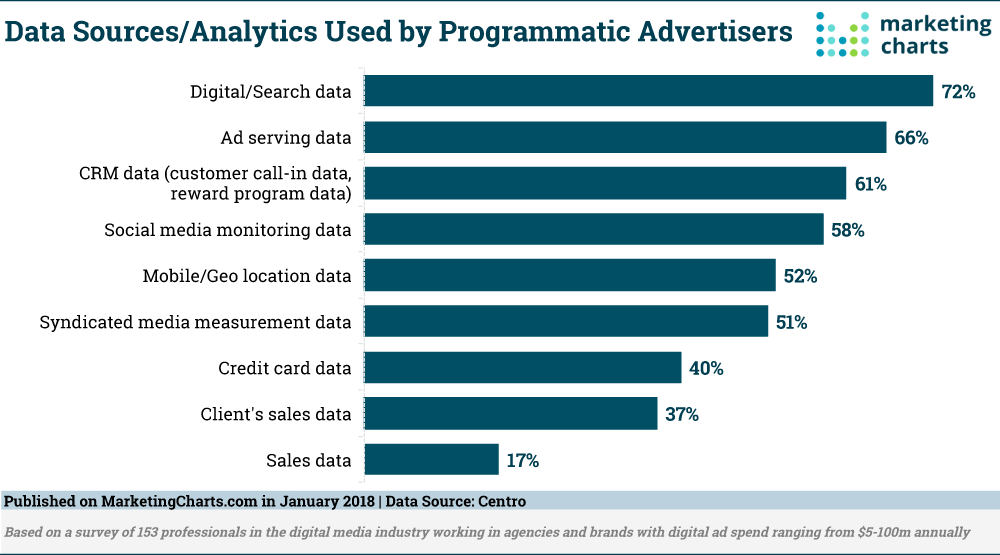Do you need programmatic advertising explained in clear and speedy terms?
We’ve created this beginner’s guide to walk you through exactly what programmatic buying is, and why it’s the most important digital marketing initiative your business needs.
From New York to Shanghai, programmatic display advertising is changing how brands advertise online.
According to an Adobe Think Tank, by 2022, 80% of advertising processes will be automated.
If you’ve been paying attention – that means the future is here.
Here’s the opportunity to orientate yourself and your brand on programmatic, using this quick and dirty guide.
What you’ll learn:
- What Does Programmatic Mean?
- Briefly Define Programmatic Advertising
- A History of Programmatic Marketing
- Programmatic Advertising 101
- An Example of Programmatic Advertising
- Types of Programmatic Ads Explained
- Display Advertising vs. Programmatic: Are They the Same?
- Real-Time Bidding vs. Programmatic: Are They the Same?
- How Much Does Programmatic Advertising Cost?
- Why Should Brands Care About Programmatic Marketing?
- TL;DR – What Have We Learned
Photo by Joshua Earle on Unsplash
What Does Programmatic Mean?
According to the Oxford Dictionary, the word programmatic refers to the nature of a method, program or schedule.
In an advertising context, programmatic simply means ‘automated.’
If someone refers to programmatic in marketing, they’re speaking about the nature of buying, selling and placing advertising using automation – or software – to do it.
It may be a redundant phrase in the near future, as all advertising becomes programmatic. But hey, maybe digital marketers will keep the term, because it’s lofty and fun to say in team meetings. We’re excited for the day programmatic advertising just becomes ‘advertising.’
The future of advertising will be personalized, automated, immersive, experiential and measurable. It won’t feel like advertising.
— Giselle Abramovich, Senior & Strategic Editor, CMO.com
Briefly Define Programmatic Advertising
Programmatic advertising is also called programmatic buying or marketing – they all refer to the same thing.
Here’s a good definition:
Programmatic advertising is the automated buying and selling of digital ad space.
Software uses collected data to decide which adverts to use, and how much it costs.
The goal for advertisers is to get their ad shown to the right person, at the right time, for the least cost. The goal for ad space sellers is to fill their inventory and make money.
Here’s a simplified definition:
The process of using software to automatically buy and sell ads online.
The Two Ad Perspectives
There are two perspectives when it comes to programmatic ad buying or selling.
- The Brand Perspective
- The Marketers Perspective
It gets a little more complex if you lose track of which perspective you’re coming from. You need programmatic advertising explained from both of these points of view, for greater content.
The Brand Perspective
Brands think of programmatic advertising as a way to optimize their online ad spend. Programmatic advertising software focuses on targeting specific brand audiences so that the ads work better, and sell more products or services.
For brands, approaching a company who has the right software and knows how to use it is key. This means finding an advertising company who has the best technology, and can effectively consolidate their ad spend across multiple channels.
Programmatic marketing is what companies like War Room do. We connect brand advertisers to enormous ad networks, and help them pick the right type of ad, where it will go and who it will reach, in real time.
The Marketing Perspective
Demand Side Platform (DSP)
Demand Side Platforms focus on programmatic buying.
They connect brand advertisers to available ad space online. War Room uses Kedet, a type of DSP, as mentioned above. DSP’s use technology to get the best deals and results for their clients.
Supply Side Platform (SSP)
Supply Side Platforms focus on programmatic selling.
They’re connected to the same ad exchanges and networks, only to negotiate ad space for sale. This ad space is called inventory, and it’s their job to fill it with ads for profit.
Ad buying and selling require the right algorithms so that placements are efficiently optimized. These often come in the form of AI or artificial intelligence systems.
Kedet is War Room’s proprietary AI stack and is made up of sophisticated algorithms that automatically adjust ad bids in real-time – depending on who is using the web page at the time. It gives our clients access to the largest programmatic marketplace available online.
Brands are looking to partner with the best possible programmatic buyer, and DSPs are charged with using their specific programmatic software to attract brand advertisers.
Once aligned with a DSP, the brand’s adverts are automatically connected to massive ad networks and SSPs, where ultra-fast bidding takes place in real-time.
A History of Programmatic Marketing
The programmatic advertising industry is enormous!
65% of digital media ads were traded programmatically in 2019, according to Zenith’s Programmatic Marketing Forecast. And that number is only going to rise.
But where did it come from?
Here’s the history of programmatic marketing explained:
It started with display advertising, all the way back in 1994 – when the very first display ad was published on Hotwired.com. A site you know today, as Wired.com.
It looked like this:

Back in the old-timey days of 1994, this display ad got a Click-Through-Rate of 40-50%! As the years rolled by, and more advertisers vied for clicks, those rates dropped dramatically. By the time the 2000s arrived, ad networks were springing up to get advertisers more reach, across multiple websites. Then came Google, and Adwords (now Google Ads). Google did some amazing things with online advertising, including coming up with the idea to define target segments. It was almost programmatic, but not quite.
Other companies were developing methods of optimizing ad reach too – About.com, Sprinks, and Gator were building targeted ad networks. Like all fast-paced innovative growth, when you have multiple companies working to be the best, you can’t stop progress.
Suddenly, real-time bidding software sprang to life. This Real-Time Bidding (RTB) software connected Demand Side and Supply Side platforms to ad networks – and focused on hyper-targeted ads using available data. It was the birth of programmatic advertising!
So, programmatic originally came about to solve the real-time bidding issues related to remnant inventory. It has now grown into so much more than that. Many brands have still never used programmatic to its fullest potential. It’s taken years of innovation for us to reach this point. The industry has faced many challenges. But now, the difference between traditional advertising and programmatic advertising is too vast to ignore.
Traditional Advertising
- A brand negotiates with an ad space provider or publisher
- Ad performance is monitored by the providers/publishers
- The publisher supplies the web and search content for online use
- The ad is placed in available inventory space
- Money leaks for the brand, as ad dollars are not effectively managed, placed, or tracked for performance
Programmatic Advertising
- Real-time bidding is the most common programmatic advertising mechanism
- Software automatically places an ad in the time it takes a visitor to load a website
- The ad is placed where and when it is likely to get the best returns
- Ad spend is tracked, monitored, and optimized for maximum efficiency
Programmatic is taking over the digital advertising landscape.
It’s reached a level of maturity that has made it safer, and more cost-effective to use today, than any previous technology or method in human history.
According to Statista, programmatically sold advertising was worth 106 billion U.S. dollars in 2019. The projections for 2020 say programmatic ad spend will reach 127 billion dollars and further grow by 20 billion by the end of 2021.
If that doesn’t communicate the growth potential of programmatic – nothing will!
Programmatic Advertising 101
We’re living in the age of big data. It’s informing most marketing practices on and offline these days.
The reason programs like War Room’s very own Kedet can target brand customers so well, is because of the available data online. Programmatic advertising wouldn’t exist without access to personal information.
Every two days, we create as much data as we did from the beginning of time, until the year 2000.
Smart programmatic advertising companies use this data to improve a host of different ad metrics and ultimately, results. Data like where you live, how old you are, and what you’ve been searching recently on Google – these, and more, are used to streamline the ads that you see.
So – data feeds the software, and the software decides – in real-time – where the ad goes.
Programmatic advertising data sources explained:
According to Centro, the 3 most valuable data sources are search, CRM, and ad serving data.
Good programmatic ad systems use these sources in their algorithms, to inform accurate decision-making in milliseconds, as ads are bought and sold in a real-time marketplace.
An Example of Programmatic Advertising
Programmatic ads are only as good as the results they produce for brands. Here’s an example of programmatic marketing done right by the car manufacturing company, Audi.
Audi couples strong creative campaigns with programmatic to get results. In preparation for the launch of their new model the Q2, they decided to personalize their marketing approach.
Types of Programmatic Ads Explained
There are many different types of programmatic advertising in the world. Here’s a breakdown of the main types, and how they’re used. You’ll get more information on how to choose the right advertising channel!
Search Advertising
Search ads, or Pay-Per-Click (PPC) ads are a subtype – or relative – of programmatic marketing because they can be automated and targeted. They will always be part of a Real-Time Bidding system, which is why programmatic gives you an edge in this space. Search advertising channels include:
- Google Ads
- Microsoft Bing Ads
- Apple Search Ads
- Baidu
- Yandex
- Yahoo!
Display Advertising
Display advertising is the most common niche associated with programmatic – and one of the highest impact. Advertisers can place highly targeted online display ads in front of potential customers, as they browse various sites.
Social Advertising
Social advertising include some of the channels mentioned below:
- TikTok
- Snapchat
- Weibo and more
Video Advertising
Video advertising that goes programmatic, maximizes the investment in your creative campaign. Programmatic video advertising is very popular and is quickly being adopted by large brands as the preferred method of optimizing digital video ad spend. Aside from Youtube, Connected TV channels and OTT (Over-The-Top) video streaming programs have become a highly-desired ad placement area for video ads
In-Stream Advertising
In-stream ads are adverts that appear in videos, before they start, as they’re playing, or at the end. Add programmatic advertising to this, and you get ads that are personalized and appealing to viewers at just the right moment.
Native Advertising
According to MarTech Advisor, native advertising that uses programmatic technology leverages machine learning and contextual signals to customize them to user preferences and put them in the right places, at the right time. Native ads already don’t look like ads, but now they’re super-targeted!
Shopping Ads
Shopping ads show users product information, and when coupled with programmatic tech – attract shoppers that are ready to buy your specific product, more often. Large retailers use automation to manage campaign bids, optimize their ad spend and increase sales.
In-App Advertising
Metasearch Advertising (aka: Hotel Ads)
Online Travel Agencies (OTA) (aka: Travel Ads)
Mobile Advertising
Audio Advertising
Online streaming platforms such as Spotify, Pandora Radio, Youtube Music and more have millions of listeners tuning in for music or podcasts. Audio ads that weave in-between songs or podcast segments are a new way to reach hyper-targeted audiences based on age group, interests and more.
Digital Out Of Home (DOOH) Ads
Frequently Asked Questions
Display Advertising vs. Programmatic: Are They the Same?
One of the most common questions asked in this field is – “Is display advertising the same as programmatic advertising?” The answer is no.
In digital advertising, display ads are adverts that contain rich content, like images, audio and video. These adverts can be promoted in a number of different ways – so they’re not all programmatic. They only become programmatic display ads, when the advertiser or DSP uses programmatic systems or tech to automatically buy the right ad placements.
This is different to direct programmatic buys – which are similar to more traditional ad buying methods. An advertiser approaches a specific platform or publisher to strike a deal. Often inventory is sold based on a fixed CPM.
Real Time Bidding vs. Programmatic: Are They the Same?
The next most popular question is –
“Is real-time bidding the same as programmatic advertising?”
Again, no.
Real-time bidding (RTB) was where programmatic started, but it’s more like a prominent subset now. It happens in open and in private ad exchanges.
RTB follows the typical auction model, buying and selling display ads in real-time, but not necessarily in an automated capacity. About 90% of real-time buying is programmatic, but you also get advertisers who use RTB for manual purchases.
Programmatic doesn’t always involve real-time bidding either.
Sometimes advertisers use fixed-price programmatic or programmatic direct to buy ad space. It’s a more traditional type of buying, but it harnesses the power of programmatic to make it more effective. At no point is real-time buying used.
Here’s programmatic advertising explained in context – it’s a much bigger, broader technology than real-time bidding.
If you’re asked about it, it’s accurate to say the two terms are not interchangeable.
How Much Does Programmatic Advertising Cost?
In a nutshell, programmatic advertising saves you money. You have your advertising budget – that won’t change. But it’s a mistake to think of programmatic in terms of overhead costs. Sure, you’ll pay your DSP company – that’s part of finding programmatic software worth using.
A company like War Room for example, makes it easier to skip the agency fees altogether, for a more direct buying model. Using cross channel attribution, we find the best conceivable touchpoints for your ads, which reduces your overall ad spend. The value lies in how much greater your conversions will be. Better, more targeted placement means more sales, faster scale, and improved performance across the board.
Why Should Brands Care About Programmatic Marketing?
At this stage, you’re wondering – why programmatic advertising? What are the benefits? There’s a very good reason why programmatic is fast eclipsing traditional online advertising.
Your company needs it for digital marketing success.
- It’s safe and transparent – It’s not 2008 anymore! You can trust most programmatic advertising agencies to be completely transparent about their pricing, processes and ad spend. The right company will make sure bots aren’t ruining your conversions, and you’ll get the best Return on Ad Spend you’ve ever had.
- Machine-learning, baby! – Did we mention AI is involved in programmatic ad buying? It’s not just real-time bidding you’re benefiting from, its machine learning algorithms. Your ad software will learn as it spends, and will make stronger decisions based on where, when and why to place your ads – the longer you use it.
- Reach more people, at the right time – We’ve been saying it all along, but just in case you skipped to this section, here it is again. If you want explosive growth with your digital advertising campaigns, this is it. By growth, we mean you’ll reach more of your ideal target buyers, and more of them will buy than ever before.
*Our inventory for example, doesn’t stop at Google Ads or Yahoo, we connect our advertisers to over 90,000+ other publisher connections!
- No more wasted ad spend – One of the most frustrating things as a marketer is wasting ad spend. It’s challenging enough driving traffic to the right converting pages or media. With programmatic advertising on your side, you eliminate waste. It’s gone forever.
Right now, 62% of media-buying folk are increasing their ad spend in areas like programmatic TV advertising – because they want to reach a more targeted audience. Not to mention, 85% of mobile ads in the US are programmatic! This is one train you don’t want to leave at the station.
If you’re interested, hop on over to our next blog, “How Does Programmatic Advertising Work?”
What Have We Learned?
Programmatic Advertising means programmatic buying or marketing. It’s the automated buying and selling of digital ad space. It means using software to automatically buy and sell ads. The common objective for all advertisers is to have their ad shown to the right audience in a timely fashion for ideally the least cost. The goal for sellers of ad space is to make money by filling their inventory.
For brands, programmatic advertising means ad spend optimization.
On the marketing end, there are:
- Demand Side Platform (DSP): Agencies like War Room are DSPs who utilize software technology and connect clients to optimal ad space online and look for the best deal.
- Supply Side Platform (SSP): SSPs focus on selling programmatically. They negotiate ad space for sale (inventory) and their duty is to fill ad spaces for profit.
War Room’s Kedet is an artificial intelligence consisting of intricate algorithms that adjust ad bids in real-time automatically.
According to marketing forecast studies, 65% of online ads are traded programmatically in 2019 and will only steadily increase.
Programmatic marketing started from display advertising in 1994 on Hotwired.com, known today as Wired.com. In 2000, sites like Google became emerging ad networks and because they had access to more reach, they began building targeted ad networks. Soon, real-time bidding software came about, which connected DSP and SSPs to the ad networks, which uses available data to deliver hyper-targeted ads.
Programmatic advertising would not exist without access to personal information. Demographic metrics like location, age, search history all allow advertisers to better pinpoint their target audience.
Programmatic Advertising’s main types include:
- Search Advertising (PPC)
- Display (Online display ads across sites)
- Social (creative messaging and wide engagement)
- Video
- In-Stream (before, during or after video streams)
- Native (machine learning + contextual signals)
- Shopping Ads (product information)
- In-App (rich data for engaged users)
- Metasearch/Hotel Ads (rates, times, costs for airlines, hotels and travel brands)
Display ads do not equal to Programmatic ads unless they are used by programmatic technology to buy ad placements automatically.
Real-Time Bidding does not equal Programmatic. 90% of RTB is programmatic but sometimes advertisers use fixed-price programmatic systems to buy ad space.
Your advertising budget may vary. An agency like War Room allows you to skip agency fees and allows for more direct buying.
Why you should consider programmatic advertising:
- It’s safe and transparent
- The AI does machine learning the more you use it, which means more targeted ads
- It allows more reach to your brand’s target audience!
- Less waste on ad spend
18 Benefits of Programmatic Media Buying
If you’re looking for ideas or content to inform your programmatic ad strategy, or to justify moving to a new Demand Side Platform (DSP) for improved results, this post is a solid resource.The benefits of programmatic media buying for your brand.More specifically,...
7 Ways to Create Content that Helps to Achieve Your Business Goals
Content is one of the most important things brands need to thrive in the digital world.It helps companies in different ways, such as building trust, increasing brand awareness, driving website traffic, and even generating leads. In this digital world, content has now...
Google Privacy Sandbox Explained
Ch-ch-changes: recently, there’s been a lot of technology innovations and policy changes shaking up the ad tech landscape, including the introduction of the Google Privacy Sandbox.Recently, movers and shakers of the internet age, such as Apple, are moving towards...










